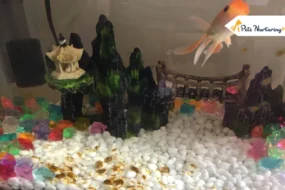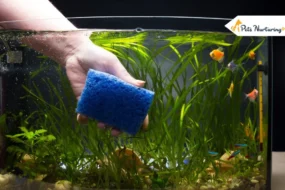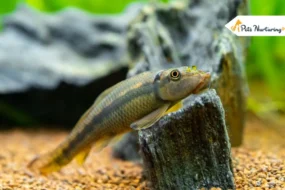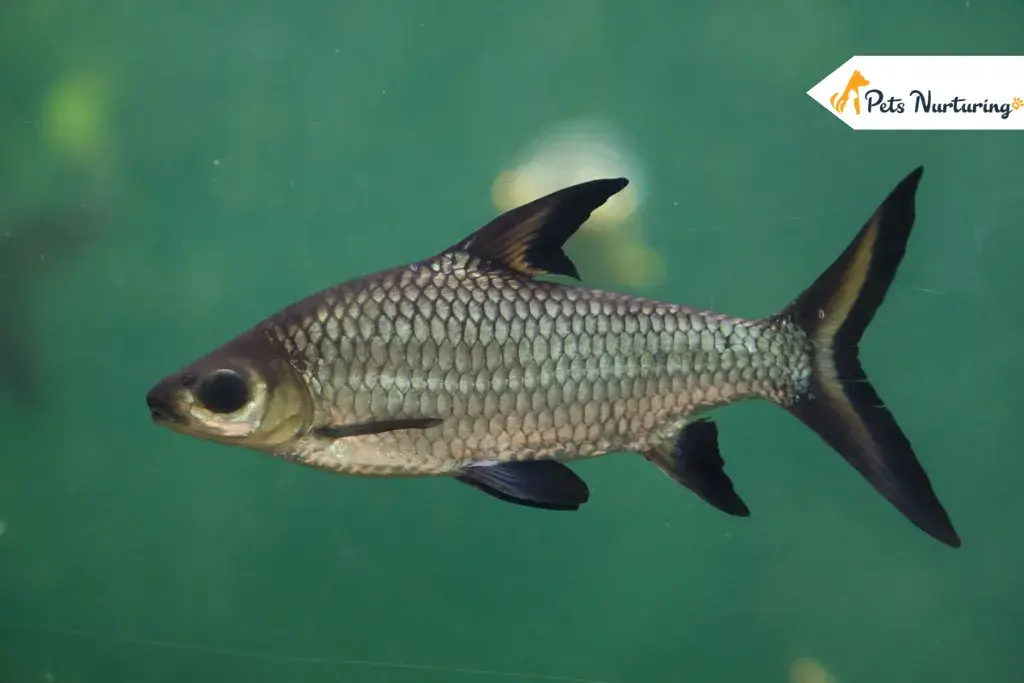
Balantiocheilos melanopterus also known as the Bala shark can be an interesting addition to your aquarium or tank. Bala sharks are not true sharks but greatly resemble sharks due to their torpedo-shaped body and large fins. They are originally from the Malay peninsula, Sumatra, and Borneo. Bala sharks have a silver body with black margins on their pelvic, dorsal, anal, and caudal fins. Their large eyes help them with locating and catching their prey. A full-grown Bala shark can measure up to 14 inches.
Bala sharks are widely available in fish stores and make peaceful and sweet companions to many other tropical fishes residing in the tank but a Bala shark’s full size can be too large for your home aquarium. Bala shark lifespan is up to 10 years so make sure you can commit to them for that long before you get them.
Basic Overview Of Bala Shark
Bala Shark Overview
Scientific name: Balantiocheilos melanopterus
Other names: Tricolour shark, tri-color shark minnow, silver shark, shark minnow, silver Bala, Malaysian shark
Origin: Southeast Asia
Size : 12-14 inches or 25-35 cm
Tank water requirement : Freshwater
Bala shark Lifespan : 10 years
Care: Easy to Intermediate
Colour: Grey, Black, and Yellow
Bala shark Diet : Omnivore
Temperament : Peaceful and sweet (gets along with other tropical species)
Minimum tank size : 100 gallons
Water pH : 6.5 to 7
Breeding : Oviparous
Bala shark belongs to the kingdom: Animalia, Phylum: Chordata, Class: Actinopterygii, Order: Cypriniformes, family: Cyprinidae, sub-family: Barbinae, and genus: Balantiocheilos. They are found in fast-flowing rivers and streams of Southeast Asian countries like Kalimantan, Malaysia, Sumatra, Thailand, and Cambodia.
In their native habitat, Bala shark fish is known by various names like a tricolor shark, silver Bala shark, silver shark, and tri-color shark minnow due to the color combination of grey, black, yellow, and unique markings. They are among the endangered species and have become rare or extinct in many of their original habitats.
Bala Shark Temperament
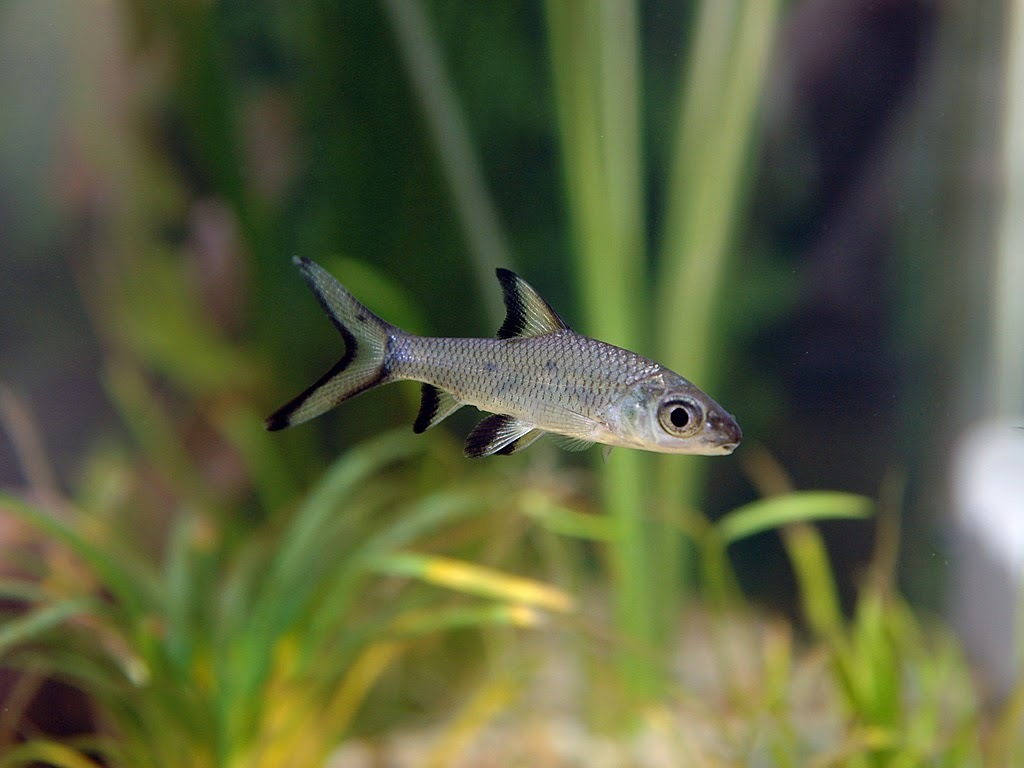
Unlike sharks, who are aggressive predators, Bala sharks are peaceful and calm. They are found traveling in large schools (group) in their natural habitats and hence we suggest you buy several of these when buying them for your aquarium as they like to be in a group. It’s ideal to keep at least 4 to 6 of them together.
They are very active and social and make your aquarium more interesting. Having the top of your aquarium closed is suggested as they are active and love to jump now and then. Add aquatic plants, roots, rocks, or other decorative items to your tank which the Bala shark fish can use as a spot to rest by hiding.
Due to their fast growth, they require a large amount of food which may lead to hogging. They may steal food meant for smaller fishes.
Bala sharks’ temperament is not aggressive but they do eat some smaller species of fishes so research well on which fishes they can be kept with. Bala sharks get along with most freshwater species of fish. Although, if you keep a Bala shark alone, it may show aggressive behavior due to stress as they live in schools of sharks naturally.
Bala sharks’ temperament is also a bit timid, they get easily scared in the new environment in their initial weeks and become more active as they eventually get comfortable.
Bala Shark Size
A Bala shark’s full size can reach up to 14 inches and they grow up pretty fast hence we only recommend them for larger aquariums with a minimum 100 gallons water holding capacity. At a young age when the Bala shark is smaller (3-5 inches) in size, they can be housed in a small aquarium but you’ll need to move them to a larger one as they grow.
Make sure they are compatible with the other smaller fishes in the aquarium as they grow. In aquariums, they may not grow as big as they do in their natural habitat and yet a full-grown Bala shark in an aquarium can reach up to 12 inches.
Make sure you are prepared for them to grow up to their maximum size before you get them. DO NOT leave them in a local water body once they are too big for a tank. Any non-indigenous fish should not end up in local water bodies and unwanted fishes must be euthanized instead of leaving them into new and unknown waters.
Bala Shark Appearance
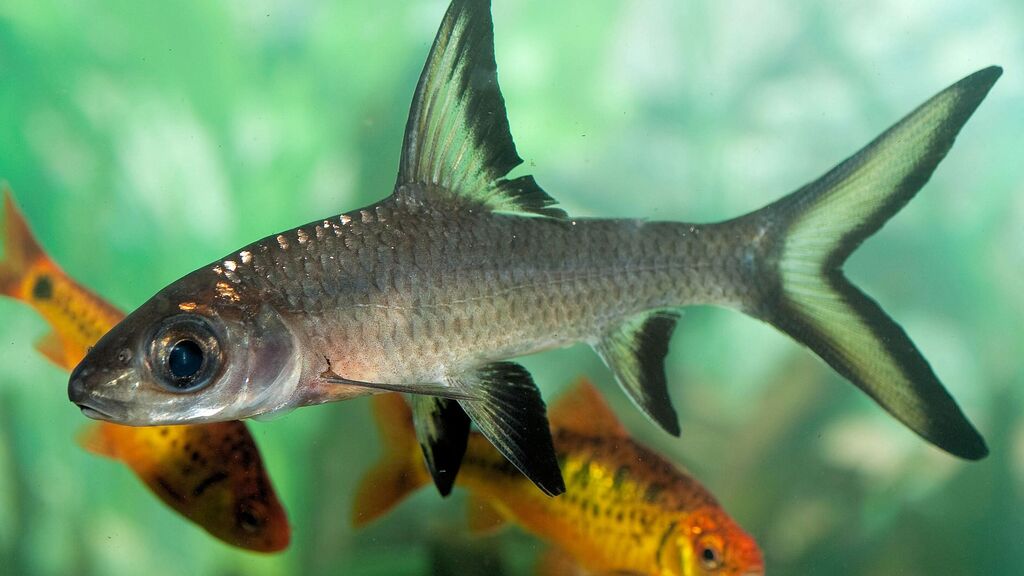
They have an elongated torpedo-shaped body which gives them a shark-like appearance. They have a single large standing dorsal fin, two ventral fins that are smaller and single-colored, smaller than the ventral fins are the anal fins. Their fins have black edges and yellow stripes. They have a forked tail with a yellow tinge.
The body of a Bala shark is grey that grows darker towards the top and brighter towards the bottom with closely placed scales. They have large eyes that allow them to focus on greater areas and aid hunting.
Bala Shark Diet
Bala shark’s food naturally consists of insects, algae, larvae of insects, small crustaceans, and various plants as they are omnivorous. High-quality dry flakes and pellets should be used as a part of their core diet to help them grow to their full potential.
They like live food as well as freeze-dried, frozen, or pellet food. Live feed options include Daphnia, brine shrimp, blood worms, tubifex worms, and mosquito larvae.
Bloodworms, vegetables, or various planktons can be added to their food to diversify their meal. Spinach, peas, and diced fresh fruits are added to provide various vitamins and minerals.
With their large size and fast-growing nature comes a high demand for protein. Shrimp or other protein-rich food should be added to their diet to meet their needs. They should be fed small portions 2 to 3 times daily.
With the right food choices, they grow happy and healthy without needing any additional supplements.
Bala Shark Care
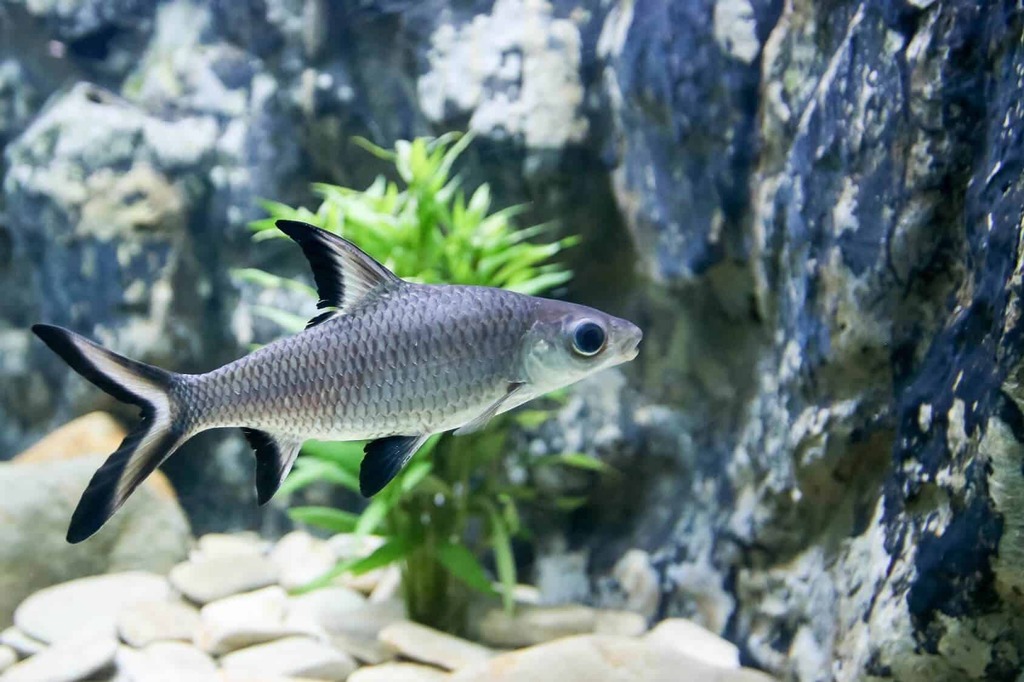
Bala shark care is not a tedious task if done correctly. The tank should be pre-planned and large enough to accommodate a full-grown Bala shark or you can initially keep them in a smaller tank and they can be shifted to a large one as they grow.
A school (4-6) of adult Bala sharks requires a minimum size tank that can hold 125 gallons of water as they are active swimmers and need room to move around. Ponds are also an option for these adorable fishes if you live in a place that has a warm climate. They can be only kept outside in a pond if the climate is warm all year round.
Bala sharks are sensitive to cold water temperature. It can develop white spot disease if the temperature of the water drops too low. The tank you keep them in should have a cover as these fishes love to jump around and that can prove to be a life risk if they fall out of the tank.
Things To Keep In Mind
Make sure the filtration is good as these fishes prefer fresh flowing water in their natural habitat. There should be high and equal oxygen distribution throughout the tank. Bala sharks are not susceptible to any one disease in particular but are very sensitive to water parameters.
The water they are kept in should always be kept clean using a good filtration facility. Never change the water completely when cleaning the tank as this may lead to a sudden change of environment for the sharks, leading to difficulty in adjusting. Partial water changes like 30% change weekly are recommended.
Do not disturb them much during the initial 20 days after you get them as this is their settling period in a new environment. They can have digestive issues if you don’t feed them good quality food.
Health Issues
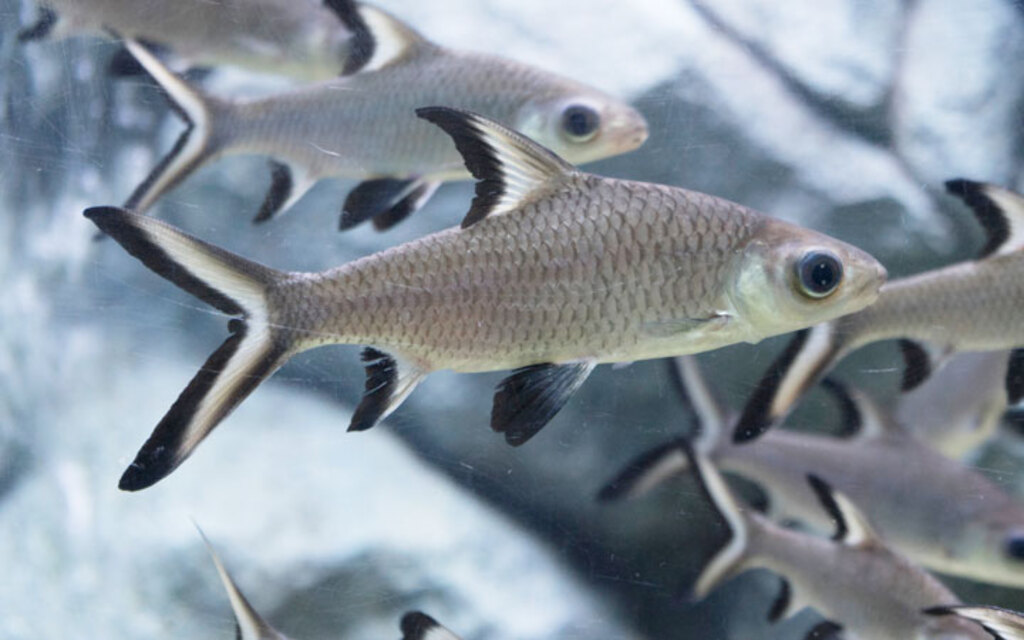
Freshwater fishes like the Bala shark are susceptible to diseases like dropsy, ich, or parasite infestation. Dropsy is caused by fluid buildup inside the fish leading to swelling up of the fish. The causative agent behind such conditions may be a parasite or bacteria.
Ich is a common infection of the dermal layer of the fish wherein you’ll notice them trying to scratch themselves against various surfaces. Small white spots are noticed on the scales of fishes infected with Ich.
Common fish diseases can be simply treated if you notice them at the right time and provide proper care and treatment. Watch them daily during their feeding time for any unusual activity or reduced appetite.
Tank Conditions
Water temperature should be maintained at around 77 degrees Fahrenheit as Bala sharks don’t do well in lower water temperatures. A water heater can be used to maintain the temperature to the desired level.
The most suitable pH for Bala sharks to thrive in is 6.5 to 8, anything below or above this range will lead to negative effects on your fish. Water hardness is another property that needs to be kept in check and the degrees of water hardness (DGH) should range from 10 to 13.
These parameters can be easily maintained in your aquarium using a water testing kit. Lighting is another important factor when it comes to tank conditions. All you need to do is provide a basic freshwater lamp that is switched on for 8 hours a day.
Bala Shark Tank Mates
Bala sharks tend to get along with various species of freshwater fishes. Although they may gobble up tiny fishes (those they can easily swallow) in the tank. This is why we will give you a heads up on which fishes make the best tank mates for your Bala sharks.
First of all, avoid keeping small fishes like guppies, neon tetras, harlequin rasbora, etc with your school of Bala sharks. Research well before adding any new fish to the tank. Bala sharks are active and move around a lot which can stress out smaller, lesser active fishes.
Do not add large fishes like the Cichlids, Red-tailed sharks, Rainbow sharks, Oscar fish, and Silver dollar fish that can act as a predator and hurt your sharks, make sure all the tank mates in your tank are safe in each other’s presence. Bala sharks love to munch on snails, hence adding snails to your aquarium won’t be a good choice.
Fishes that make up for amazing Bala shark tank mates:
- Rainbowfish
- Tetras
- Rasbora
- Corydoras
- Salvelinus (char)
- Minor tetra
- Angelfish
- Discus fish
- Blood parrot cichlid
- Gourami
- Black ghost knife fish
- Tinfoil barbs
- Clown loaches
- Common pleco fish
Bala sharks happily coexist with other fishes provided you keep them in a big enough tank with the right water conditions. It is best to keep them with fishes their size and a similar temperament. With the right care and management, Bala sharks make up for a rewarding and unique fish in your aquarium.
Many aquarists decide against owning a Bala shark due to large tank requirements but many opt to have them no matter what they have to do, for them to care for these beauties. So think hard and make sure your decision is in the best interest of these beautiful creatures.
Continue reading :








